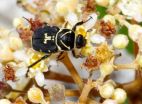(Press-News.org) COLUMBIA, Mo. – Beetles: it's what's for breakfast—at least for the red widow spider of Florida's "scrub" habitat, according to a study by University of Missouri biologist James Carrel. The study provides a first glimpse at the diet of this mysterious spider, revealing that it primarily preys upon species of scarab beetles common to the scrub habitat. Carrel's findings shed light on red widow spiders' restriction to the Florida scrub habitat and the need for habitat conservation efforts.
"The pine scrub habitat, found on sandy ridges in Central and Southeastern Florida, is one of the oldest in North America," said Carrel, Curators Professor Emeritus in the MU Division of Biological Sciences. "Many of the plants and animals found on these ridges, including the red widow spider, are restricted to these high, dry areas. Our research suggests that red widows have evolved to specialize on scarab beetles because they are reliable food sources."
Carrel said that red widow spiders are difficult to study due to habitat confinement and the hidden nature of their webs, which are built in palmetto shrubs. Red widows conceal their funnel-shaped retreats in unopened palmetto leaves, making them difficult to spot. The only clues to the spiders' presence, visible solely on foggy mornings during four months of the year, are the threads spun loosely between tips of palmetto frond.
Since 1987, Carrel has been monitoring populations of this spider at the Archbold Biological Station, which protects a 5,193-acre Florida scrub preserve near Lake Placid. Only twice in those 23 years – in March 1989 and in May 2003 – have enough webs been located to study the dietary habits of these elusive spiders. The scientists identified 43 species of insects among the 98 specimens collected. The study revealed that the primary prey of the spider, especially in early spring, are five species of scarab beetles endemic to the Florida scrub habitat.
"The scarab beetles, which often are larger and stronger than the spiders themselves, fly just above the tops of scrub vegetation," said Mark Deyrup, senior research biologist for the Archbold Biological Station, who co-authored the study. "Sometimes beetles hit the web strands between tips of palmetto fronds and tumble into the denser tangle of threads below, catching them in the red widows' webs."
Carrel has monitored red widow spider populations at the Station since 1987, but has found enough webs to study red widows' dietary habits only twice. During both time periods, Carrel worked alongside Deyrup to collect and identify prey from spiders' webs.
Carrel's study, entitled "Red widow spiders prey extensively on scarab beetles endemic in Florida scrub," appeared in the March issue of the Florida Entomologist. Funding for the study came in part from a grant from the University of Missouri in Columbia, MO.
INFORMATION:
Diet of elusive red widow spider revealed by MU biologist
2014-03-20
ELSE PRESS RELEASES FROM THIS DATE:
Dramatic new portrait helps define Milky Way's shape, contents
2014-03-20
MADISON, Wis. – Using more than 2 million images collected by NASA's orbiting Spitzer Space Telescope, a team of Wisconsin scientists has stitched together a dramatic 360 degree portrait of the Milky Way, providing new details of our galaxy's structure and contents.
The new composite picture (viewable at http://www.spitzer.caltech.edu/glimpse360), using infrared images gathered over the last decade, was unveiled today (March 20, 2014) at a TED conference in Vancouver. The galactic portrait provides an unprecedented look at the plane of our galaxy, using the infrared imagers ...
Not only is she thinner than you ... her muscles work better, too
2014-03-20
Bethesda, MD (March 20, 2014)—We all know the type: The friend or colleague who stays slim and trim without much effort and despite eating the same high-calorie fare that causes everyone else to gain weight. As it turns out, the way the muscles of the inherently thin work may give them the edge.
Daily physical activity is an inherited trait with a strong association to how fat or thin a person is. Chaitanya K. Gavini et al. previously found that aerobic capacity is a major predictor of daily physical activity level among humans and laboratory animals. In their new study, ...
New semiconductor holds promise for 2-D physics and electronics
2014-03-20
From super-lubricants, to solar cells, to the fledgling technology of valleytronics, there is much to be excited about with the discovery of a unique new two-dimensional semiconductor, rhenium disulfide, by researchers at Berkeley Lab's Molecular Foundry. Rhenium disulfide, unlike molybdenum disulfide and other dichalcogenides, behaves electronically as if it were a 2D monolayer even as a 3D bulk material. This not only opens the door to 2D electronic applications with a 3D material, it also makes it possible to study 2D physics with easy-to-make 3D crystals.
"Rhenium ...
One-third of kids with obesity 'metabolically healthy,' study shows
2014-03-20
(Edmonton) Digits on a scale can help determine a child's weight, but their overall health status can be influenced by other factors such as physical activity, diet and screen time, according to new research from the University of Alberta and Alberta Health Services.
A study of 181 children with obesity aged eight to 17 years old showed that up to a third could be classified as "metabolically healthy," meaning they're not imminently at risk of developing insulin resistance—a precursor to Type 2 diabetes—high blood pressure, high cholesterol or other obesity-related diseases.
"It's ...
Pseudogap theory puts physicists closer to high temperature superconductors
2014-03-20
Physicists are one step closer to developing the world's first room-temperature superconductor thanks to a new theory from the University of Waterloo, Harvard and Perimeter Institute.
The theory explains the transition phase to superconductivity, or "pseudogap" phase, which is one of the last obstacles to developing the next generation of superconductors and one of the major unsolved problems of theoretical condensed matter physics.
Their work was published in this week's issue of the prestigious journal Science.
Superconductivity is the phenomenon where electricity ...
Potential lung cancer vaccine shows renewed promise
2014-03-20
(SACRAMENTO, Calif.) — Researchers at UC Davis have found that the investigational cancer vaccine tecemotide, when administered with the chemotherapeutic cisplatin, boosted immune response and reduced the number of tumors in mice with lung cancer. The study also found that radiation treatments did not significantly impair the immune response. The paper was published on March 10 in the journal Cancer Immunology Research, an American Association for Cancer Research (AACR) publication.
Though tecemotide, also known as Stimuvax, has shown great potential at times, the recent ...
Ancient clam gardens nurture food security
2014-03-20
A three-year study of ancient clam gardens in the Pacific Northwest has led researchers, including three from Simon Fraser University, to make a discovery that could benefit coastal communities' food production. PLOS ONE, a peer-reviewed science journal, has just published their study.
Amy Groesbeck, an SFU alumna, SFU professors Anne Salomon, an ecologist, and Dana Lepofsky, an archaeologist, and Kirsten Rowell, a University of Washington biologist are the authors.
The researchers discovered that ancient clam gardens made by Aboriginal people produced quadruple the ...
Genome-wide association studies mislead on cardiac arrhythmia risk gene
2014-03-20
Although genome-wide association studies have linked DNA variants in the gene SCN10A with increased risk for cardiac arrhythmia, efforts to determine the gene's direct influence on the heart's electrical activity have been unproductive. Now, scientists from the University of Chicago have discovered that these SCN10A variants regulate the function of a different gene, SCN5A, which appears to be the primary gene responsible for cardiac arrhythmia risk. The SCN10A gene itself plays only a minimal role in the heart, according to the study, published in the Journal of Clinical ...
Oregon physicists use geometry to understand 'jamming' process
2014-03-20
EUGENE, Ore. -- (March 20, 2014) -- University of Oregon physicists using a supercomputer and mathematically rich formulas have captured fundamental insights about what happens when objects moving freely jam to a standstill.
Their approach captures jamming -- the point at which objects come together too tightly to move -- by identifying geometric signatures. The payoff, while likely far down the road, could be a roadmap to preventing overfilled conveyor belts from stopping in factories, separating oil deposits trapped in sand, or allowing for the rapid, efficient transfer ...
Mayo Clinic researchers find genetic clue to irritable bowel syndrome
2014-03-20
ROCHESTER, Minn. — March 20, 2014 — Is irritable bowel syndrome (IBS) caused by genetics, diet, past trauma, anxiety? All are thought to play a role, but now, for the first time, researchers have reported a defined genetic defect that causes a subset of IBS. The research was published in the journal Gastroenterology.
Researchers estimate that approximately 15 to 20 percent of the Western world has IBS. It is a common disorder that affects the large intestine. Most patients with the disorder commonly experience symptoms of cramping, abdominal pain, bloating gas, diarrhea ...






